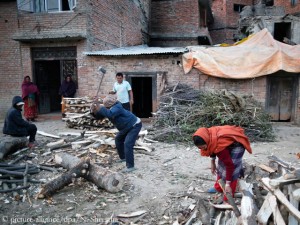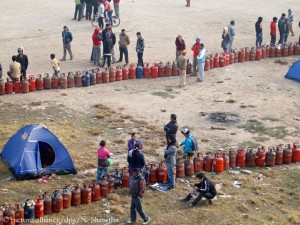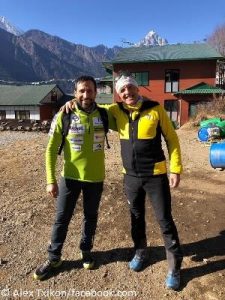No prospect of spring fever in Nepal
If there is a season, which stands for optimism, it’s spring: Winter is leaving, it’s getting warmer, brighter, more colorful. This may entice people painting the world more beautiful than it is soberly assessed. Also the people in Nepal long for spring, in the hope of better times. 2015 was a bad year for the country. First the devastating earthquake in spring that killed according to official figures more than 8800 people. And were this not bad enough, the blockade of the border to India, now continuing for almost four months. There is still no sign of spring fever in Nepal.
Ambivalent feeling
Fuel, food and medicine are still scarce because the imports from India have been staying away. The blockade holds the reconstruction in the earthquake hit regions up. Tourism is affected too. The conditions for operators of trekking and expeditions in Nepal are far from ideal. His agency was still able to obtain fuel, ensure flights and organize food, “of course often on the black market”, Manfred Haeupl, head of the German operator Hauser Exkursionen writes to me, adding that he has an “ambivalent feeling, because we want and should send tourists, while on the other hand the locals are suffering”.
Double standards
“The booking situation is far from having recovered”, Haeupl says. “We are currently still about 30 percent below the number of bookings in 2015. The NTB [Nepal Tourism Board] does nothing to boost tourism, but has now increased the entry fees.” In contrast, the Nepalese government waives visa fees for visitors from China since the beginning of the year. Perhaps the authorities in Kathmandu should think about such a gesture to Western tourists too.
Less bookings, but uptrend
Other large German operators as the DAV Summit Club and Amical Alpin note a similar decline in bookings for trips to Nepal as Hauser does. “Compared to 2015, we have currently 26 percent less bookings for next spring “, Markus Herrmann, product manager of DAV Summit Club, writes to me. However, his company is now recording an increasing demand for Nepal traveling. “Things are once again looking up”, says Herrmann.
Via Kathmandu or Lhasa?
Dominik Mueller, head of Amical alpin, is cautiously optimistic too. Their scheduled spring expedition to the eight-thousander Makalu in Nepal is “already well booked and thus secured”, says Mueller. However, he refers to uncertainties before the upcoming season: “For us as expedition operators it’s still an open question whether China will open the border with Tibet for expeditions, so that we can organize our equipment material and also our arrival via Nepal. Of course, an arrival via Lhasa is possible too but means significantly higher costs.”
The great silence
Whereas the 2015 earthquake in Nepal made headlines around the world for weeks, hardly anyone seems to be interested in the conflict in the Nepal-India border region. The ethnic group of Madhesis, who live in the border area, initiated the blockade to protest against the new constitution of Nepal, through which they feel discriminated. The government in Kathmandu accuses India of actively supporting the blockade, the authorities in New Delhi dispute this.
At the end of November, UN Secretary General Ban Ki-moon said, he was “alarmed by reports of the obstruction, and destruction, of life-saving medical supplies and continued impact on humanitarian operations” in Nepal, urging all sides to resolve their differences. Ban underlined Nepal’s right of free transit.
I didn’t find any statement of a Western government on the conflict. My questions to the German Foreign Ministry, what they think of the problem and whether they have already contacted India on this issue or intend to do so, are still unanswered.









